YouTube Dominance in Sustainability of Gaining Knowledge via Social Media in University Setting—Case Study
Abstract
:1. Introduction
- The upper half represents the closer surroundings which is the physical contact—for us, the real world,
- The lower half represents the outside environment where we even do not have to be physically present,
- The left part stands for the official sources—school, official media—CNN, BBC; that can be someone who is responsible for the information, someone who is supposed to be objective,
- The right part stands for the subjective, affective area encompassing the learner’s interests, emotions, motivation, perceptions, aspirations and degree of acceptance.
2. State of the Art
3. Research Methodology
3.1. Research Sample
3.2. Research Approach
3.2.1. Data Collection Methods
- (1)
- Gender
- (2)
- Type of student (Erasmus student, full-time or part-time student)
- (3)
- Year of studies
- (4)
- Social media—Usage
- (5)
- Social media—Satisfaction
- (6)
- YouTube in detail—Satisfaction
- (7)
- Activity you do on YouTube.
- (8)
- Time on YouTube—Total time of watching a day
- (9)
- Time on YouTube—Number of Videos a day
- (10)
- Usage of YouTube
- (11)
- Additions on YouTube.
3.2.2. Qualitative Research Methods
4. Results
4.1. Demographic Distribution of Respondents
4.2. Utilization of Social Media
4.3. Satisfaction
4.4. YouTube in Detail
- Almost 90% of respondents have a profile on YouTube and rate videos with “like” or “dislike.”
- Creating playlists is also very common, which is also perfectly suitable and desirable for our purposes, as well as sharing on other platforms.
- Fewer than half of respondents make comments, and only a quarter add videos.
5. Discussion
6. Conclusions
Author Contributions
Funding
Acknowledgments
Conflicts of Interest
References
- Twitter by the Numbers (2020): Stats, Demographics & Fun Facts 2020. Available online: https://www.omnicoreagency.com/twitter-statistics/ (accessed on 3 March 2020).
- Smith, A.; Toor, S.; van Kessel, P. Many Turn to YouTube for Children’s Content, News, How-To Lessons. Pew Research Center. 2018. Available online: https://www.pewresearch.org/internet/2018/11/07/many-turn-to-youtube-for-childrens-content-news-how-to-lessons/ (accessed on 8 March 2020).
- Greenhow, C.; Lewin, C. Social media and education: Reconceptualizing the boundaries of formal and informal learning. Learn. Media Technol. 2016, 41, 6–30. [Google Scholar] [CrossRef]
- Prensky, M.R. Teaching Digital Natives: Partnering for Real Learning; Corwin Press: Thousand Oaks, CA, USA, 2010; ISBN 978-1-4522-0725. [Google Scholar]
- Tapscott, D. Grown up Digital: How the Net Generation is Changing Your World, 1st ed.; McGraw-Hill Education: New York, NY, USA, 2009; ISBN 978-0-07-150863-6. [Google Scholar]
- Greenhow, C.; Burton, L. Help from My “Friends”: Social Capital in the Social Network Sites of Low-Income Students. J. Educ. Comput. Res. 2011, 45, 223–245. [Google Scholar] [CrossRef]
- Margaryan, A.; Littlejohn, A.; Vojt, G. Are digital natives a myth or reality? University students’ use of digital technologies. Comput. Educ. 2011, 56, 429–440. [Google Scholar] [CrossRef]
- Putnam, R.D.; Putnam, P. Bowling Alone: The Collapse and Revival of American Community; Simon and Schuster: New York, NY, USA, 2000; ISBN 978-0-7432-0304-3. [Google Scholar]
- Shah, V.; Nojin Kwak, R.; Lance Holbe, D. “Connecting” and “Disconnecting” With Civic Life: Patterns of Internet Use and the Production of Social Capital. Polit. Commun. 2001, 18, 141–162. [Google Scholar] [CrossRef]
- Hargittai, E.; Hsieh, Y.P. Predictors and consequences of differentiated practices on social network sites. Inf. Commun. Soc. 2010, 13, 515–536. [Google Scholar] [CrossRef]
- Hargittai, E.; Litt, E. The tweet smell of celebrity success: Explaining variation in Twitter adoption among a diverse group of young adults. New Media Soc. 2011, 13, 824–842. [Google Scholar] [CrossRef] [Green Version]
- Černá, M. Potential of Social Media Not Only in Collaborative Learning: Expectations and Reality Case Study. In Hybrid Learning: Innovation in Educational Practices; Springer International Publishing: Cham, Switzerland, 2015; Volume 9167, pp. 137–148. [Google Scholar]
- Weller, K. Trying to understand social media users and usage: The forgotten features of social media platforms. Online Inf. Rev. 2016, 40, 256–264. [Google Scholar] [CrossRef]
- Černá, M.; Svobodová, L.; Haviger, J. Perception and Utilization of Facebook by University Students: Case Study; Academic Conferences International Limited: Sonning Common, UK, 2017; pp. 105–113. [Google Scholar]
- Chugh, R.; Ruhi, U. Social media in higher education: A literature review of Facebook. Educ. Inf. Technol. 2018, 23, 605–616. [Google Scholar] [CrossRef]
- Lambić, D. Correlation between Facebook use for educational purposes and academic performance of students. Comput. Hum. Behav. 2016, 61, 313–320. [Google Scholar] [CrossRef]
- Dougan, K. “YouTube Has Changed Everything”? Music Faculty, Librarians, and Their Use and Perceptions of YouTube. CRL 2014, 75, 575–589. [Google Scholar] [CrossRef] [Green Version]
- Jia, S. Literature Review of YouTube in Teaching Activities. In Proceedings of the PACIS 2019, Xi’an, China, 8–12 July 2019; p. 228. Available online: https://aisel.aisnet.org/pacis2019/228 (accessed on 8 March 2020).
- Snelson, C. YouTube across the Disciplines: A Review of the Literature. Merlot J. Online Learn. Teach. 2011, 7, 159–169. [Google Scholar]
- Svobodová, L. Utilization and Benefits of YouTube for the Educational Purposes: A Review Study; Academic Conferences International Limited: Sonning Common, UK, 2016; pp. 789–793. [Google Scholar]
- Cheung, K.S. A comparison of Webct, blackboard and moodle for the teaching and learning of continuing education courses. In Enhancing Learning through Technology; World Scientific: Hong Kong, China, 2006; pp. 219–228. [Google Scholar]
- Cheung, S.K.S. The Open Textbooks for Hong Kong: From Conceptualization to Implementation. In Blended Learning: Aligning Theory with Practices; Lecture Notes in Computer Science; Cheung, S.K.S., Kwok, L., Shang, J., Wang, A., Kwan, R., Eds.; Springer International Publishing: Cham, Switzerland, 2016; Volume 9757, pp. 150–160. ISBN 978-3-319-41164-4. [Google Scholar]
- Černá, M.; Poulová, P.; Žumárová, M. Utilization of Learning Management Systems & Social Networking Systems not only in the Process of Education. In Proceedings of the Recent Researchess in Communications, Electrical & Computer Engineering; World Scientific and Engineering Academy and Society and Society Press: Playa Meloneras, Gran Canaria, Canary Islands, Spain, 2011; pp. 154–159. Available online: http://www.wseas.us/e-library/conferences/2011/Meloneras/ACELAE/ACELAE-26.pdf (accessed on 19 October 2020).
- Pilli, O. LMS vs. SNS: Can Social Networking Sites Act as a Learning Management Systems? AIJCR 2014, 4, 90–97. [Google Scholar]
- Steyn, R.; Millard, S.; Jordaan, J. The Use of a Learning Management System to Facilitate Student-Driven Content Design: An Experiment. In Emerging Technologies for Education; Huang, T.-C., Lau, R., Huang, Y.-M., Spaniol, M., Yuen, C.-H., Eds.; Springer International Publishing: Cham, Switzerland, 2017; pp. 75–94. [Google Scholar]
- Park, C.L.; Crocker, C.; Nussey, J.; Springate, J.; Hutchings, D. Evaluation of a Teaching Tool—Wiki—In Online Graduate Education. J. Inf. Syst. Educ. 2010, 21, 313. [Google Scholar]
- Ricaurte-Quijano, P.; Carli-Álvarez, A. The Wiki Learning Project: Wikipedia as an Open Learning Environment. Comun. Media Educ. Res. J. 2016, 24. [Google Scholar] [CrossRef] [Green Version]
- Madge, C.; Meek, J.; Wellens, J.; Hooley, T. Facebook, social integration and informal learning at university: ‘It is more for socialising and talking to friends about work than for actually doing work’. Learn. Media Technol. 2009, 34, 141–155. [Google Scholar] [CrossRef] [Green Version]
- Prescott, J.; Wilson, S.; Becket, G. Facebook use in the learning environment: Do students want this? Learn. Media Technol. 2013, 38, 345–350. [Google Scholar] [CrossRef]
- Černá, M.; Borkovcová, A. Blended Learning Concept in Selected Tourism Management e-Courses with Focus on Content Development Including Recommender System. In Blended Learning. Enhancing Learning Success; Cheung, S.K.S., Kwok, L., Kubota, K., Lee, L.-K., Tokito, J., Eds.; Lecture Notes in Computer Science; Springer International Publishing: Cham, Switzerland, 2018; Volume 10949, pp. 175–187. ISBN 978-3-319-94504-0. [Google Scholar]
- Smith, K. 57 Fascinating and Incredible YouTube Statistics. Available online: https://www.brandwatch.com/blog/youtube-stats/ (accessed on 25 July 2020).
- Van Kessel, P. 10 facts about Americans and YouTube. Pew Research Center. 2019. Available online: https://www.benton.org/content/10-facts-about-americans-and-youtube-pew-research-center (accessed on 19 February 2020).
- Jones, T.; Cuthrell, K. YouTube: Educational Potentials and Pitfalls. Comput. Sch. 2011, 28, 75–85. [Google Scholar] [CrossRef]
- Zahn, C.; Pea, R.; Hesse, F.W.; Rosen, J. Comparing Simple and Advanced Video Tools as Supports for Complex Collaborative Design Processes. J. Learn. Sci. 2010, 19, 403–440. [Google Scholar] [CrossRef]
- DeWitt, D.; Alias, N.; Siraj, S.; Yaakub, M.Y.; Ayob, J.; Ishak, R. The Potential of Youtube for Teaching and Learning in the Performing Arts. Procedia Soc. Behav. Sci. 2013, 103, 1118–1126. [Google Scholar] [CrossRef] [Green Version]
- Černá, M. Utilization of Social Applications as a Way of Student’s Engagement into a Learning Process. Adv. Sci. Lett. 2017, 23, 2889–2893. [Google Scholar] [CrossRef]
- Černá, M.; Poulová, P.; Sláma, M. Utilization of web Portals at Kazakh and Czech University-Comparative Study. In Proceedings of the 13th European Conference on e-Learning ECEL 2014, Copenhagen, Denmark, 30–31 October 2014; pp. 113–120. [Google Scholar]
- Klimova, B.; Poulova, P. Older People and Technology Acceptance. In Human Aspects of IT for the Aged Population. Acceptance, Communication and Participation; Zhou, J., Salvendy, G., Eds.; Lecture Notes in Computer Science; Springer International Publishing: Cham, Switzerland, 2018; Volume 10926, pp. 85–94. ISBN 978-3-319-92033-7. [Google Scholar]
- Černá, M.; Poulová, P. Role of social media in academic setting awareness, utilization and willingness. In Proceedings of the 2013 IEEE 11th International Conference on Emerging eLearning Technologies and Applications (ICETA), Stara Lesna, Slovakia, 24–25 October 2013; pp. 59–62. [Google Scholar]
- Polkinghorne, D.E. Language and meaning: Data collection in qualitative research. J. Couns. Psychol. 2005, 52, 137–145. [Google Scholar] [CrossRef] [Green Version]
- Pernecky, T. Epistemology and Metaphysics for Qualitative Research; Sage: Thousand Oaks, CA, USA, 2016. [Google Scholar]
- Černá, M. Development of Acceptance and Utilization of Social Software Applications in Higher and Further Education. In Proceedings of the INTED2014, Valencia, Spain, 10–12 March 2014; pp. 4300–4307. [Google Scholar]
- Andrews, M.; Squire, C.; Tamboukou, M. Doing Narrative Research; SAGE: Thousand Oaks, CA, USA, 2008; ISBN 978-1-4129-1197-9. [Google Scholar]
- Etherington, K. Narrative Approaches to Case Studies. Available online: https://www.keele.ac.uk/media/keeleuniversity/facnatsci/schpsych/documents/counselling/conference/5thannual/NarrativeApproachestoCaseStudies.pdf (accessed on 19 October 2020).
- Luo, A. Discourse Analysis. A Step-by-Step Guide with Examples. Available online: https://www.scribbr.com/methodology/discourse-analysis/ (accessed on 7 October 2020).
- Jia, J.; Yu, Y. Online Learning Activity Index (OLAI) and Its Application for Adaptive Learning. In Blended Learning. New Challenges and Innovative Practices; Cheung, S.K.S., Kwok, L., Ma, W.W.K., Lee, L.-K., Yang, H., Eds.; Springer International Publishing: Cham, Switzerland, 2017; pp. 213–224. [Google Scholar]
- Samet, A. 2020 US Social Media Usage: How the Coronavirus is Changing Consumer Behavior—Business Insider. Available online: https://www.businessinsider.com/2020-us-social-media-usage-report (accessed on 25 July 2020).
- Watson, A. Media Usage during COVID-19 by Country. Available online: https://www.statista.com/statistics/1106498/home-media-consumption-coronavirus-worldwide-by-country/ (accessed on 25 July 2020).
- Coronavirus Disease 2019 (COVID-19) Updates—YouTube Help. Available online: https://support.google.com/youtube/answer/9777243?hl=en (accessed on 7 October 2020).
- Lin YouTube Reducing Video Quality during Coronavirus. The Sacramento Bee. Available online: https://www.sacbee.com/news/coronavirus/article241505306.html (accessed on 25 July 2020).
- Koran, M. “Every day looks absolutely wild”: The chaos of teaching during a pandemic. Guardian, 5 June 2020. [Google Scholar]
- Aktuální Informace o COVID-19—Oficiální Informační Portál Ministerstva Zdravotnictví České Republiky. Available online: https://koronavirus.mzcr.cz/ (accessed on 7 October 2020).
- Nejčastější Dotazy ke Školství a Koronaviru, MŠMT ČR. Available online: https://www.msmt.cz/nejcastejsi-dotazy-ke-skolstvi-a-koronaviru-1?lang=1 (accessed on 7 October 2020).
- Elia, G.; Solazzo, G.; Lorenzo, G.; Passiante, G. Assessing learners’ satisfaction in collaborative online courses through a big data approach. Comput. Hum. Behav. 2019, 92, 589–599. [Google Scholar] [CrossRef]
- Iandoli, L.; Quinto, I.; De Liddo, A.; Buckingham Shum, S. On online collaboration and construction of shared knowledge: Assessing mediation capability in computer supported argument visualization tools. J. Assoc. Inf. Sci. Technol. 2016, 67, 1052–1067. [Google Scholar] [CrossRef] [Green Version]
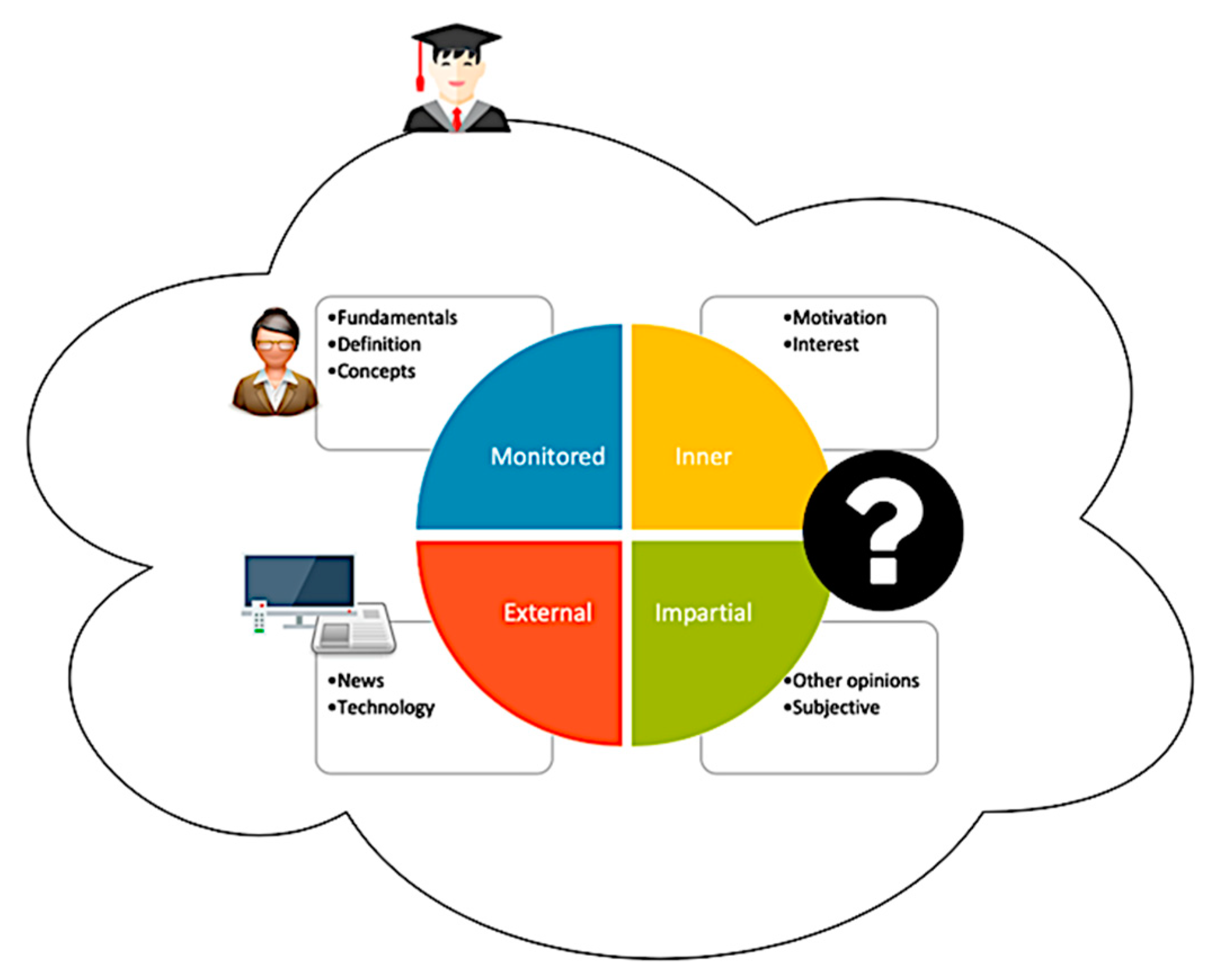
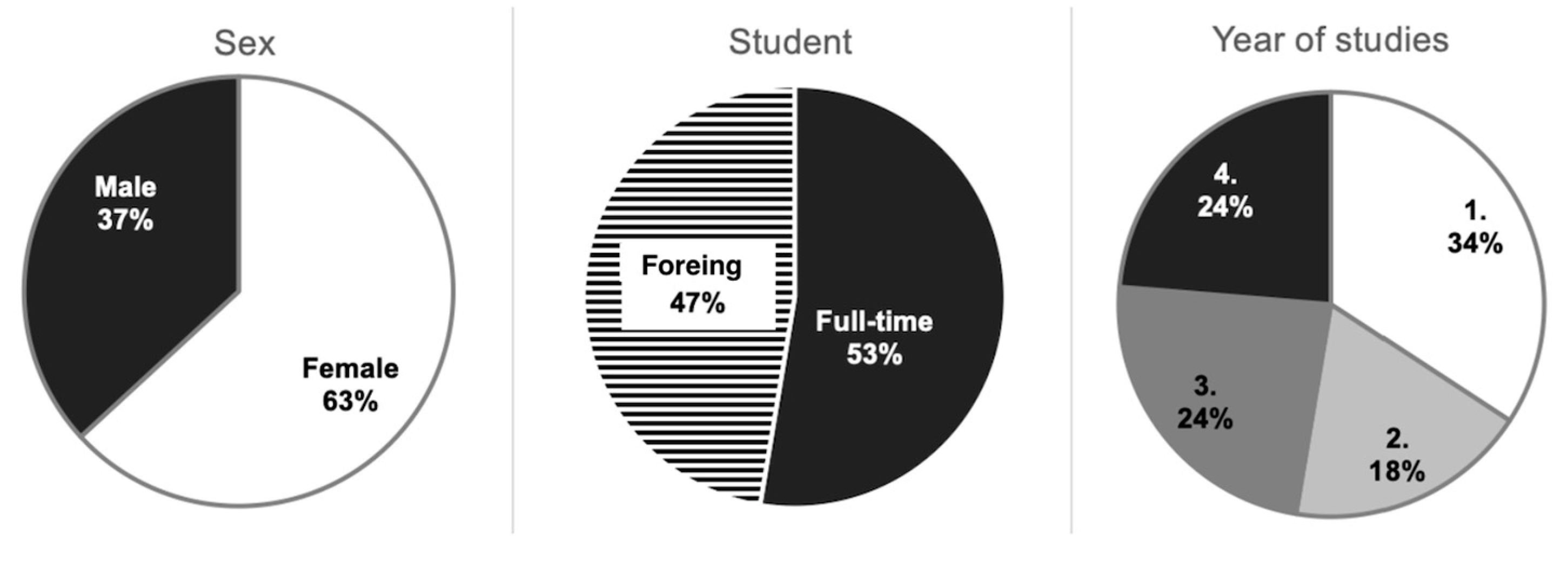

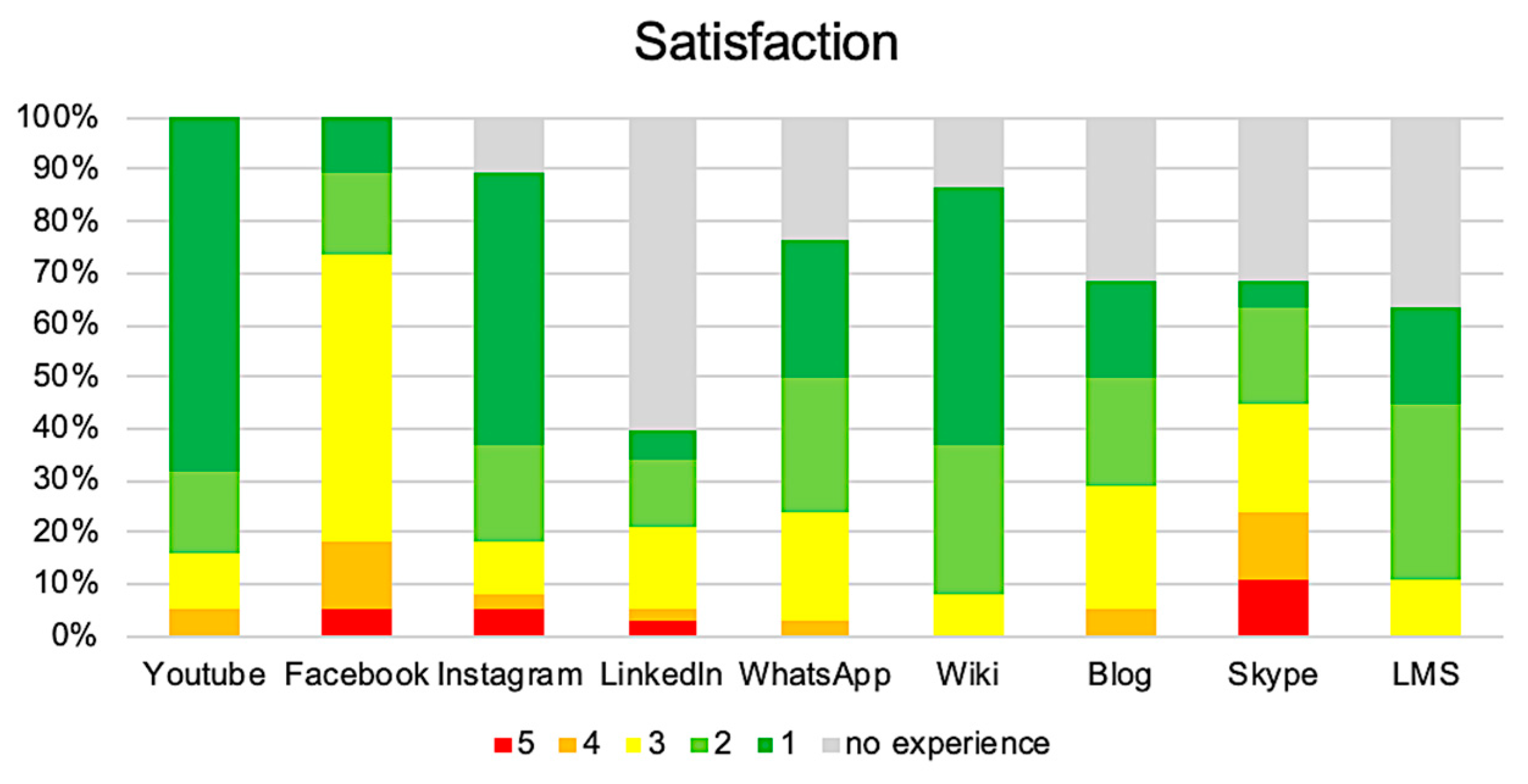
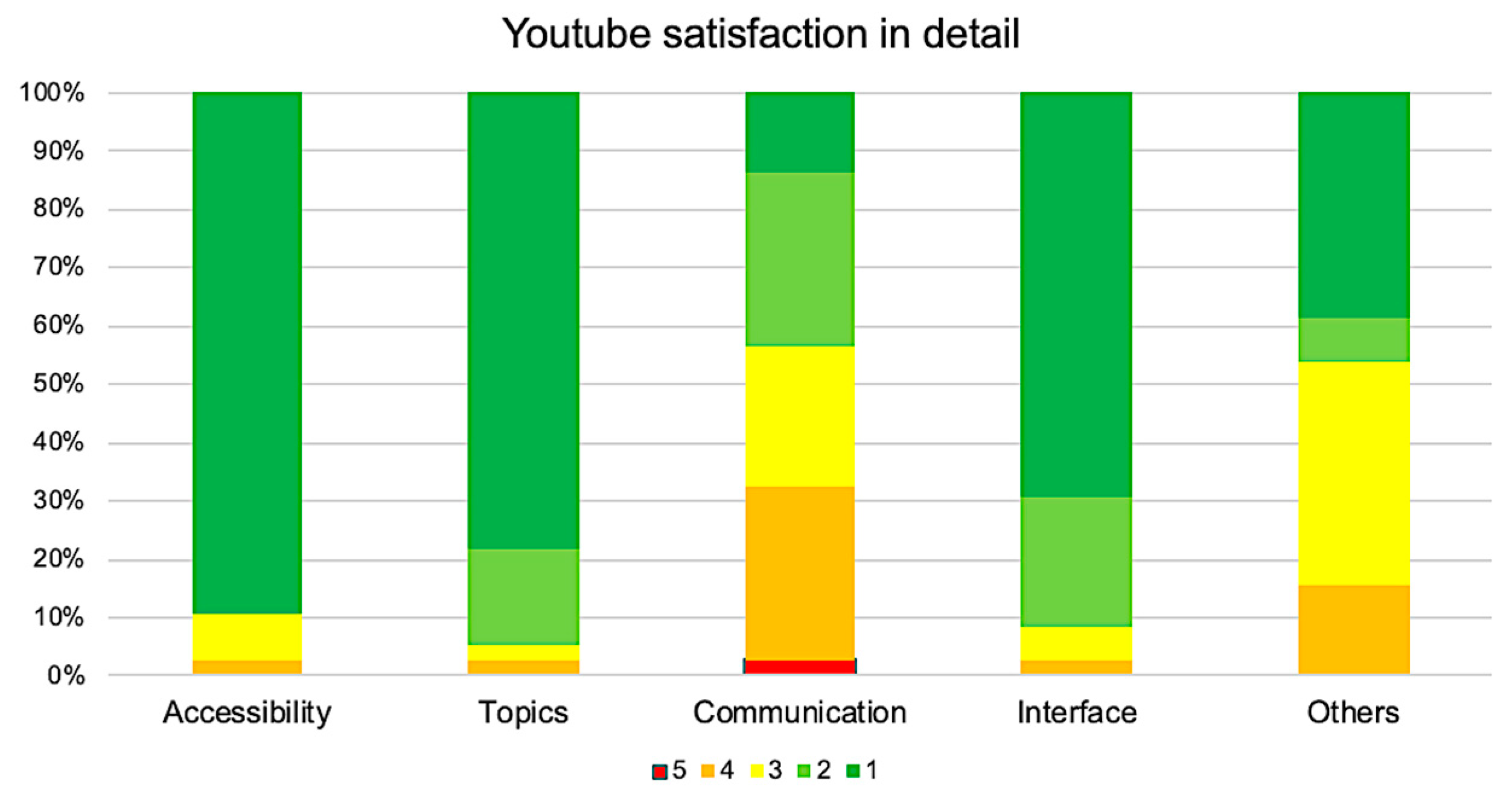

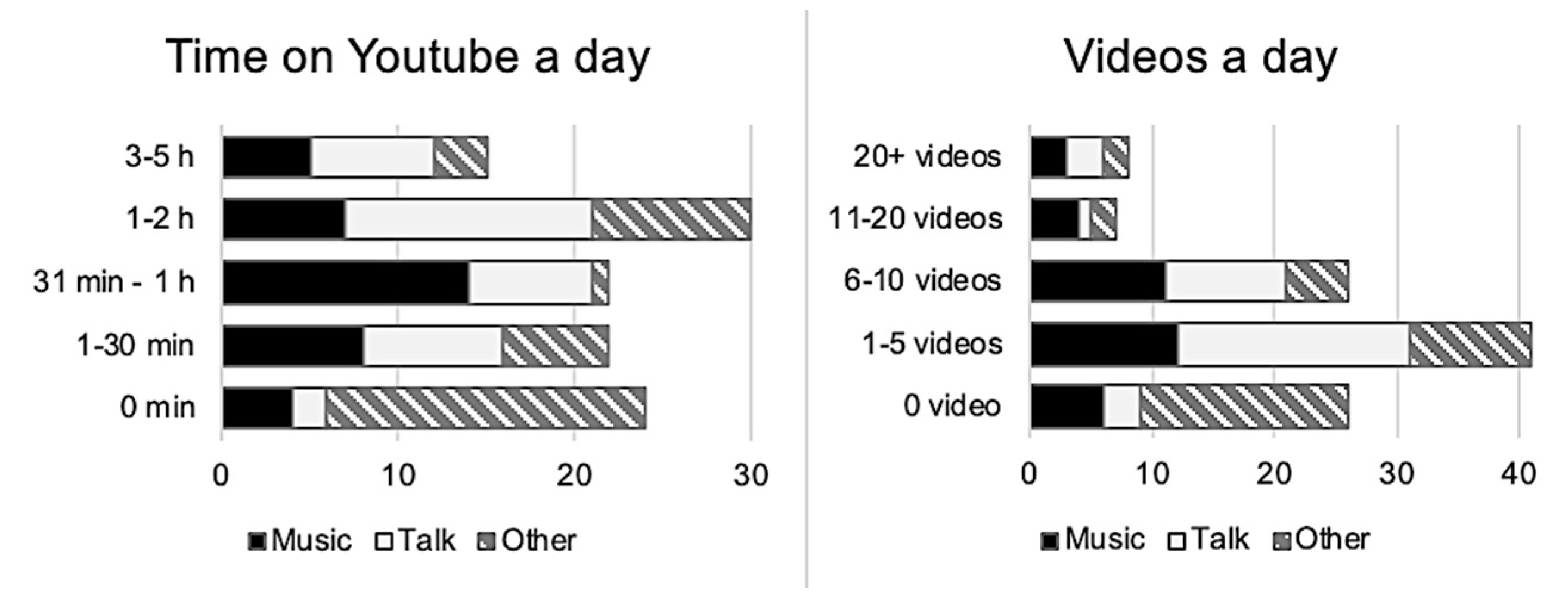
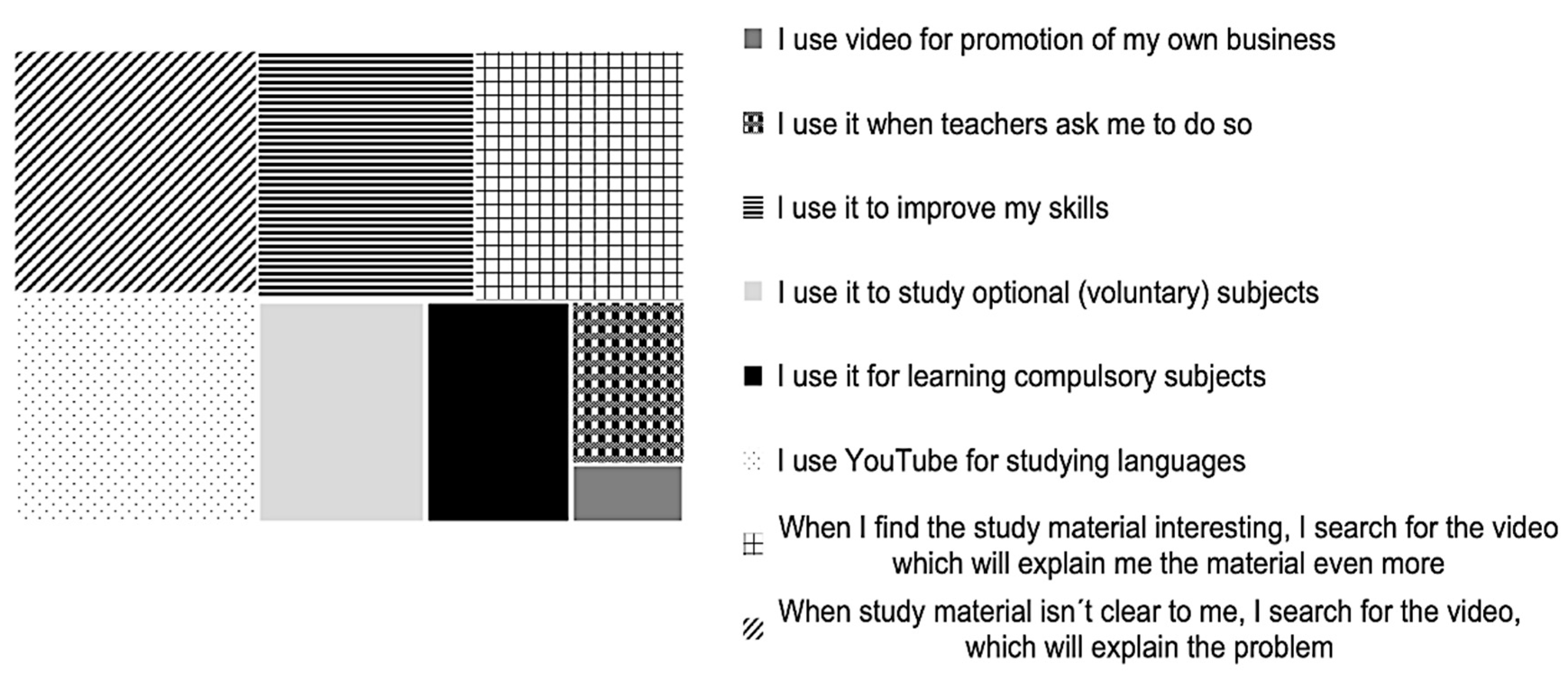
| A | OoT | C | I | O | |
|---|---|---|---|---|---|
| Erasmus | 1.20 | 1.29 | 2.21 | 1.46 | 2 |
| Female | 1 | 1.11 | 2 | 1.33 | 1 |
| Male | 1.60 | 1.60 | 2.60 | 1.75 | 3.00 |
| Full-time | 1.20 | 1.20 | 3.30 | 1.25 | 2.38 |
| Female | 1 | 1.36 | 3.45 | 1.18 | 1 |
| Male | 1.44 | 1 | 3.11 | 1.33 | 3.20 |
| Total | 1.20 | 1.24 | 2.85 | 1.33 | 2.30 |
| YouTube Satisfaction | YouTube in Detail | |
|---|---|---|
| Mean | 1.459459459 | 1.685585586 |
| Observations | 40 | 40 |
| Hypothesized mean difference | 0 | |
| df | 39 | |
| t Stat | −1.784733543 | |
| P(T <= t) one-tail | 0.041366926 | |
| t Critical one-tail | 1.688297714 | |
| P(T <= t) two-tail | 0.082733853 | |
| t Critical two-tail | 2.028094001 |
Publisher’s Note: MDPI stays neutral with regard to jurisdictional claims in published maps and institutional affiliations. |
© 2020 by the authors. Licensee MDPI, Basel, Switzerland. This article is an open access article distributed under the terms and conditions of the Creative Commons Attribution (CC BY) license (http://creativecommons.org/licenses/by/4.0/).
Share and Cite
Černá, M.; Borkovcová, A. YouTube Dominance in Sustainability of Gaining Knowledge via Social Media in University Setting—Case Study. Sustainability 2020, 12, 9126. https://doi.org/10.3390/su12219126
Černá M, Borkovcová A. YouTube Dominance in Sustainability of Gaining Knowledge via Social Media in University Setting—Case Study. Sustainability. 2020; 12(21):9126. https://doi.org/10.3390/su12219126
Chicago/Turabian StyleČerná, Miloslava, and Anna Borkovcová. 2020. "YouTube Dominance in Sustainability of Gaining Knowledge via Social Media in University Setting—Case Study" Sustainability 12, no. 21: 9126. https://doi.org/10.3390/su12219126
APA StyleČerná, M., & Borkovcová, A. (2020). YouTube Dominance in Sustainability of Gaining Knowledge via Social Media in University Setting—Case Study. Sustainability, 12(21), 9126. https://doi.org/10.3390/su12219126





